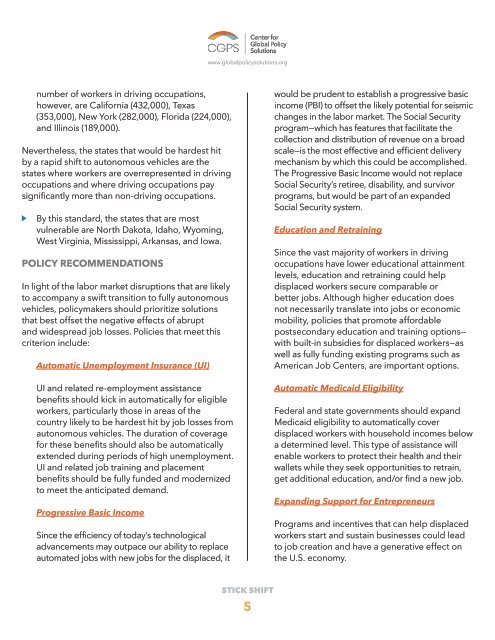STICK SHIFT
Stick-Shift-Autonomous-Vehicles
Stick-Shift-Autonomous-Vehicles
Create successful ePaper yourself
Turn your PDF publications into a flip-book with our unique Google optimized e-Paper software.
www.globalpolicysolutions.org<br />
number of workers in driving occupations,<br />
however, are California (432,000), Texas<br />
(353,000), New York (282,000), Florida (224,000),<br />
and Illinois (189,000).<br />
Nevertheless, the states that would be hardest hit<br />
by a rapid shift to autonomous vehicles are the<br />
states where workers are overrepresented in driving<br />
occupations and where driving occupations pay<br />
significantly more than non-driving occupations.<br />
By this standard, the states that are most<br />
vulnerable are North Dakota, Idaho, Wyoming,<br />
West Virginia, Mississippi, Arkansas, and Iowa.<br />
POLICY RECOMMENDATIONS<br />
In light of the labor market disruptions that are likely<br />
to accompany a swift transition to fully autonomous<br />
vehicles, policymakers should prioritize solutions<br />
that best offset the negative effects of abrupt<br />
and widespread job losses. Policies that meet this<br />
criterion include:<br />
Automatic Unemployment Insurance (UI)<br />
UI and related re-employment assistance<br />
benefits should kick in automatically for eligible<br />
workers, particularly those in areas of the<br />
country likely to be hardest hit by job losses from<br />
autonomous vehicles. The duration of coverage<br />
for these benefits should also be automatically<br />
extended during periods of high unemployment.<br />
UI and related job training and placement<br />
benefits should be fully funded and modernized<br />
to meet the anticipated demand.<br />
Progressive Basic Income<br />
Since the efficiency of today’s technological<br />
advancements may outpace our ability to replace<br />
automated jobs with new jobs for the displaced, it<br />
would be prudent to establish a progressive basic<br />
income (PBI) to offset the likely potential for seismic<br />
changes in the labor market. The Social Security<br />
program—which has features that facilitate the<br />
collection and distribution of revenue on a broad<br />
scale—is the most effective and efficient delivery<br />
mechanism by which this could be accomplished.<br />
The Progressive Basic Income would not replace<br />
Social Security’s retiree, disability, and survivor<br />
programs, but would be part of an expanded<br />
Social Security system.<br />
Education and Retraining<br />
Since the vast majority of workers in driving<br />
occupations have lower educational attainment<br />
levels, education and retraining could help<br />
displaced workers secure comparable or<br />
better jobs. Although higher education does<br />
not necessarily translate into jobs or economic<br />
mobility, policies that promote affordable<br />
postsecondary education and training options—<br />
with built-in subsidies for displaced workers—as<br />
well as fully funding existing programs such as<br />
American Job Centers, are important options.<br />
Automatic Medicaid Eligibility<br />
Federal and state governments should expand<br />
Medicaid eligibility to automatically cover<br />
displaced workers with household incomes below<br />
a determined level. This type of assistance will<br />
enable workers to protect their health and their<br />
wallets while they seek opportunities to retrain,<br />
get additional education, and/or find a new job.<br />
Expanding Support for Entrepreneurs<br />
Programs and incentives that can help displaced<br />
workers start and sustain businesses could lead<br />
to job creation and have a generative effect on<br />
the U.S. economy.<br />
<strong>STICK</strong> <strong>SHIFT</strong><br />
5


